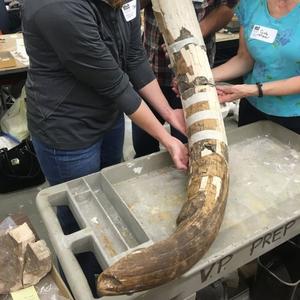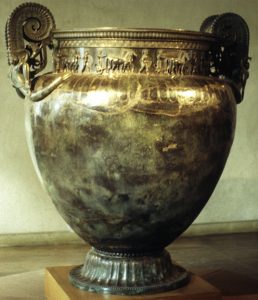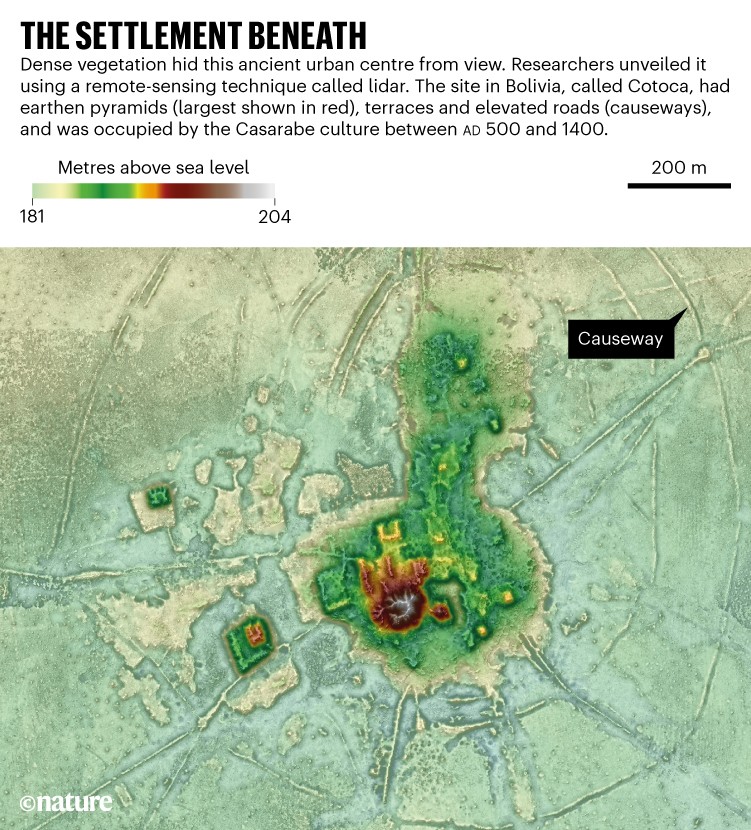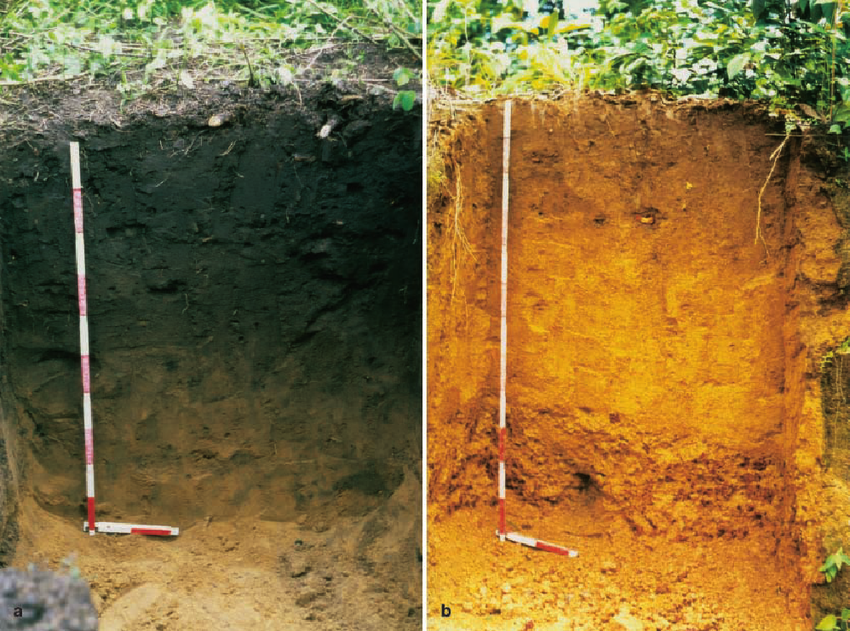Stone tools found near mastodon remains by a Florida State University (FSU) team show that early humans were in North Florida roughly 1,500 years earlier than originally thought. In the 1980s and 1990s, two researchers, David Webb and James Dunbar, found a mastodon tusk (Figure 1) in an underwater sinkhole in the Aucilla River called the Page-Ladson Site. In 2014, stone tools were retrieved from this site (FSU 2016).

Figure 1. FSU researchers hold the mastodon tusk found at the Page-Ladson Site. (https://artsandsciences.fsu.edu/article/ancient-tools-and-bone-found-north-florida-river-could-help-rewrite-story-first-americans)
Various organic material from the same layer as the tools and tusk was recovered from sediments in the lake, including seeds, plant fragments, and twigs, allowing for radiocarbon dating to determine that the artifacts found are over 14,500 years old. A stone cutting instrument was discovered, indicating that the early humans in Florida created these stone tools (Bower 2016).
This site is the oldest known site of humans in the southeast (FSU 2016). This finding allowed archaeologists to conclude that people lived in Florida far earlier than previously thought, indicating that the Page-Ladson site was once home to Clovis and pre-Clovis people. (Halligan, et al. 2016). These early humans lived alongside megafauna in Florida, i.e. mastodons, giant ground sloths, giant armadillos, and saber-toothed cats (Kelley, et al. 2015). The tools found indicate that the Clovis and pre-Clovis people living there relied on the megafauna, especially mastodons, as a food source.
One of the tools found was a biface—a sharp knife used for butchering animals—and upon further investigation of the mastodon tusk found earlier, archaeologists concluded that the markings on the tusk corresponded to those that the biface would have made as early humans cut the tusk to remove it from the skull of the mastodon to consume the tissue found in the tusk (FSU 2016). Another stone tool (Figure 2) found submerged in the lake indicates that early humans hunted mastodons, or at least scavenged from them after another predator took the mastodon down (Bower, 2016).

Figure 2. A stone tool found in sediment at the Page-Ladson site that indicates that humans lived in Florida 14,500 years ago. (https://www.snexplores.org/article/hunter-gatherers-roamed-florida-14500-years-ago)
Additionally, Sporormiella, a type of fungus found in the dung of plant-eating animals, was found in high concentrations in the layers of sediment taken from the same layer as the tools, indicating that early humans and megafauna coexisted in North Florida. There was no evidence of the fungus in 12,600 years old sediment, leading researchers to the conclusion that megafauna went extinct around 12,600 years ago (Bower, 2016).
Humans did not abandon the area after these megafauna went extinct, however. The early Clovis and pre-Clovis people ate whatever they could, and they adapted to the area to stay there long after the megafauna went extinct.
Reference list:
“Ancient Tools and Bone Found in North Florida River Could Help Rewrite the Story of the First Americans.” Florida State University: College of Arts and Sciences. Last modified May 16, 2016. Accessed September 25, 2022. https://artsandsciences.fsu.edu/article/ancient-tools-and-bone-found-north-florida-river-could-help-rewrite-story-first-americans.
Bower, Bruce. “Hunter-Gatherers Roamed Florida 14,500 Years Ago.” Science News Explores. Last modified May 29, 2016. Accessed September 25, 2022. https://www.snexplores.org/article/hunter-gatherers-roamed-florida-14500-years-ago.
Halligan, Jessi J., Michael R. Walters, Angelina Perrotti, Ivy J. Owens, Joshua M. Feinberg, Mark D. Bourne, Brendan Fenerty, Barbara Winsborough, David Carlson, Daniel C. Fischer, Thomas W. Stafford, and James S. Dunbar. “Pre-Clovis Occupation 14,550 Years Ago at the Page-Ladson Site, Florida, and the Peopling of the Americas.” Abstract. Science Advances 2, no. 5 (May 13, 2016). Accessed September 25, 2022. https://www.science.org/doi/10.1126/sciadv.1600375.
Kelley, Cynthia D., Thomas J. Fellers, and Michael W. Davidson. “Darkfield Digital Image Gallery: Pleistocene Mammal Bone From Florida.” Molecular Expressions: Exploring the World of Optics and Microscopy. Last modified November 13, 2015. Accessed September 25, 2022. https://micro.magnet.fsu.edu/optics/olympusmicd/galleries/darkfield/mammalbondpleistocenlow.html#:~:text=Quaternary%20megafaunal%20mammals%20that%20are,%2C%20Ice%20Age%20bison%20.
Additional Content:
https://youtu.be/gmayKozVQ4w
https://www.ancient-origins.net/news-evolution-human-origins/first-humans-florida-lived-alongside-giant-animals-002518





















